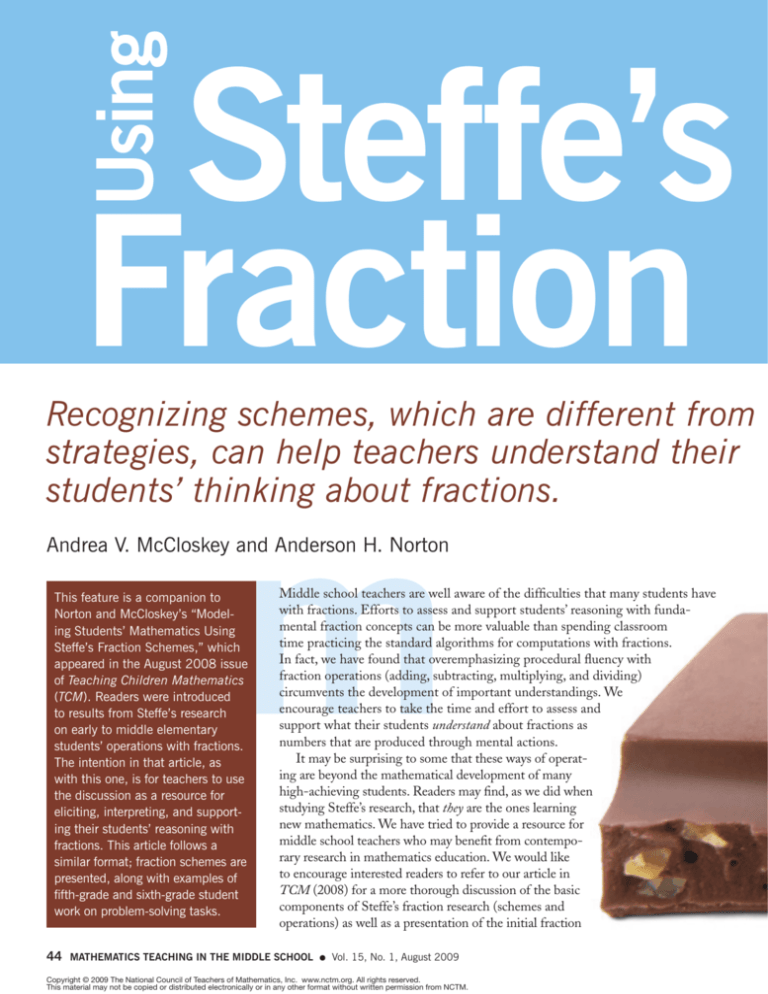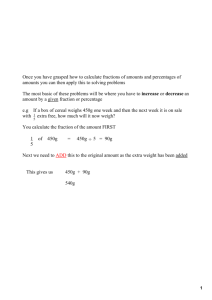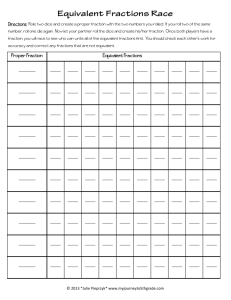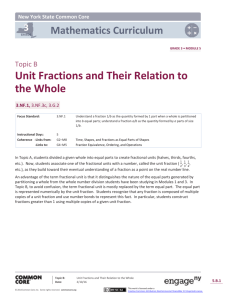
Using
Steffe’s
Fraction
Recognizing schemes, which are different from
strategies, can help teachers understand their
students’ thinking about fractions.
m
Andrea V. McCloskey and Anderson H. Norton
This feature is a companion to
Norton and McCloskey’s “Modeling Students’ Mathematics Using
Steffe’s Fraction Schemes,” which
appeared in the August 2008 issue
of Teaching Children Mathematics
(TCM). Readers were introduced
to results from Steffe’s research
on early to middle elementary
students’ operations with fractions.
The intention in that article, as
with this one, is for teachers to use
the discussion as a resource for
eliciting, interpreting, and supporting their students’ reasoning with
fractions. This article follows a
similar format; fraction schemes are
presented, along with examples of
fifth-grade and sixth-grade student
work on problem-solving tasks.
44
Middle school teachers are well aware of the difficulties that many students have
with fractions. Efforts to assess and support students’ reasoning with fundamental fraction concepts can be more valuable than spending classroom
time practicing the standard algorithms for computations with fractions.
In fact, we have found that overemphasizing procedural fluency with
fraction operations (adding, subtracting, multiplying, and dividing)
circumvents the development of important understandings. We
encourage teachers to take the time and effort to assess and
support what their students understand about fractions as
numbers that are produced through mental actions.
It may be surprising to some that these ways of operating are beyond the mathematical development of many
high-achieving students. Readers may find, as we did when
studying Steffe’s research, that they are the ones learning
new mathematics. We have tried to provide a resource for
middle school teachers who may benefit from contemporary research in mathematics education. We would like
to encourage interested readers to refer to our article in
TCM (2008) for a more thorough discussion of the basic
components of Steffe’s fraction research (schemes and
operations) as well as a presentation of the initial fraction
MATHEMATICS TEACHING IN THE MIDDLE SCHOOL
L
Vol. 15, No. 1, August 2009
Copyright © 2009 The National Council of Teachers of Mathematics, Inc. www.nctm.org. All rights reserved.
This material may not be copied or distributed electronically or in any other format without written permission from NCTM.
OLIVIER BLONDEAU/ISTOCKPHOTO.COM
Advanced
Schemes
Vol. 15, No. 1, August 2009
L
MATHEMATICS TEACHING IN THE MIDDLE SCHOOL
45
Table 1 Fractional operations—mental actions used by students
Operation
Description
Unitizing
Treating an object or collection of objects as a Treating two hexagons as a whole (as with
unit or whole
pattern blocks)
Partitioning
Separating a unit/whole into equal parts
Sharing a pizza among four people
Disembedding
Imaginatively pulling out a fraction from the
whole while keeping the whole intact and
unaltered
After the pizza has been sliced in fourths,
imagining what three-fourths of the pizza
would look like
Iterating
Repeating a part to produce identical copies
of it
Using a one-fifth piece to identify a threefifths piece (as with fraction rods)
Splitting
The simultaneous composition of partitioning
and iterating
“This bar is five times as long as another bar.
Draw the other bar.”
schemes. We also recommend several
other articles (Steffe 2004; Steffe and
Olive 1991).
OPERATIONS VERSUS
SCHEMES
Operations are mental actions that
have been abstracted from experience
to become available for use in various situations. In the middle grades,
as well as the lower grades, there are
several important fraction operations:
unitizing, partitioning, disembedding,
and iterating. They are summarized in
table 1 with one additional operation,
splitting, which is discussed below.
Operations constitute the key component of schemes; such operations,
or mental actions, produce students’
concepts of fractions.
Schemes are constructs used by
teachers and researchers to model
students’ cognitive structures. We attribute schemes to students to explain
and predict students’ actions and in so
doing provide information about instruction. It is common to misinterpret
schemes as strategies because both are
of interest to teachers who pay close
attention to their students’ problemsolving activities. The difference is that
schemes describe ways of operating
that usually occur outside the student’s
awareness. Also, schemes are activated
at once, rather than in a sequential
46
Example of Using the Operation
manner. We present a summary of
Steffe’s fraction schemes in table 2.
The first five schemes are explored in
depth in TCM (Norton and McCloskey 2008). This article discusses the
reversible partitive fractional scheme
and the iterative fractional scheme.
We caution against the temptation to teach these schemes directly to
students. Their ways of operating are
deeply connected to how they make
meaning out of their mathematics. Attempts to circumvent or replace those
ways of operating will only yield disconnected knowledge. Teachers should
find ways to work within their students’
ways of operating while generating a
need to develop more powerful ways of
operating. Although this is not easy, we
hope that the terms, tasks, and student
work examples will serve as a resource
to teachers seeking to do just that.
The partitive fractional scheme is
the first scheme in which students
coordinate units at two levels. Given
an unpartitioned piece representing
four-sevenths, for example, a student
working with this scheme would be
able to consider the quantity in two
ways. First, the student would recognize that the piece is four-sevenths of
some unpartitioned whole. Second,
the student understands that the piece
is four iterations of the one-seventh
unit while the whole is seven iterations
MATHEMATICS TEACHING IN THE MIDDLE SCHOOL
L
Vol. 15, No. 1, August 2009
of that same unit. In other words, the
student is developing powerful ways of
operating so that he or she can iterate
and partition creatively to determine
the size of a fractional piece.
When teachers support students by
providing opportunities for multiple
experiences in which students can
both iterate and partition in the same
setting, students may be able to abstract the splitting operation.
THE SPLITTING OPERATION
According to Steffe (2003), splitting
is the simultaneous composition (that
is, the recognition that one implies
the other as an inverse operation) of
partitioning and iterating. As defined
in table 1, partitioning involves breaking a piece into segments; iterating
involves duplicating a piece a number
of times. Beyond partitioning and
iterating sequentially, students who
are “splitters” can exploit the inverse
nature of these two operations to solve
problems and re-create the whole
from any fractional piece.
A student may be able to partition to solve the task “Find one-third
of this bar” and may be able to solve
the task “Find a bar 4 times as long
as this bar” by iterating. However, the
splitting operation would enable him
or her to solve this significantly harder
task: “This bar is five times as long as
Table 2 Fractional schemes—constructs used by practitioners to characterize student thinking
Scheme
Operations
Sample Task
Simultaneous
partitioning scheme
Unitizing the whole, partitioning the continuous Share this candy bar equally among you and
whole using a composite unit as a template
two friends.
Part-whole scheme
Unitizing, partitioning, disembedding a part
from the partitioned whole
Show me two-thirds of the candy bar.
Equi-partitioning
scheme
Unitizing, partitioning, iterating any part to
determine its identity with the other parts
If you share this candy bar equally among
you and two friends, show me what your
piece would look like.
Partitive unit
fractional scheme
Iterating a given unit fraction to produce a
continuous partitioned unitized whole
If I give you this much [show a one-third
piece and an unpartitioned whole], what
fraction of the candy bar would you have?
Partitive fractional
scheme
Unitizing, disembedding a proper fraction
from the whole, hypothetically partitioning the
proper fraction to produce a unit fraction,
iterating the unit fraction to produce the proper
fraction and the whole, coordinating unit
fractions within a composite fraction (units
coordinating at two levels)
If I give you this much [show an
unpartitioned two-thirds piece and
unpartitioned whole], what fraction
of the candy bar would you have?
Reversible partitive
fractional scheme
Splitting (that is, partitioning and then iterating) an unpartitioned piece of a larger whole
to re-create the whole
If the bar is four-fifths as long as your candy
bar [show an unpartitioned piece], draw
what your candy bar would look like.
Iterative fractional
scheme
Splitting (that is, partitioning and then iterating) an unpartitioned piece of a smaller whole
to re-create the whole
If the bar is five-fourths as long as your
candy bar [show an unpartitioned piece],
draw what your candy bar would look like.
another bar. Draw the other bar.” This
latter task is posed using language that
is suggestive of iterating, rather than
the necessary partitioning. A student
who can split recognizes the appropriate use of partitioning to arrive at the
solution. This student realizes that the
given piece was produced using iteration, and must, therefore, partition to
re-create a single whole.
Students who can split have
reached a significant stage in their
understanding of fractions. Since they
are able to flexibly and simultaneously iterate and partition, they are in
a position to develop some advanced
fraction schemes, such as the reversible partitive fractional scheme (see
table 2). We have found that identifying students as being possible “splitters” can be helpful to teachers as they
seek to foster fraction learning.
Fig. 1 This student is a “splitter.” He drew the correct answer, erased it, and drew his
new answer to align with the original bar. He then partitioned to verify his answer.
5. The bar shown below is four times as long as another bar. Draw the other bar.
We demonstrate with figures 1
and 2. In figure 1, the student found
the correct answer, so we may conclude that he is a “splitter.” Since we
are interested in not merely whether
students got questions right but also
in what we can infer about student
understanding, we cannot help but
Vol. 15, No. 1, August 2009
L
notice the additional marks the student erased.
A haphazard analysis might lead
to the conclusion that this student is
still tentative in his splitting. However,
after our careful consideration, this
student seemed to first draw a piece
underneath the bar, without aligning it
MATHEMATICS TEACHING IN THE MIDDLE SCHOOL
47
with the leftmost edge of the bar above.
He seemed, in other words, to estimate
the answer, which is not far off. This
student seems to be able to use the
partitioning operation imaginatively,
without relying on the corresponding
physical motions. If this is true and the
student only later drew the partitions
and disembedded one of them, then he
may in fact be a very strong splitter.
The work shown in figure 2
demonstrates other student perceptions. Although recognizing the need
to partition to re-create the whole,
this student confused an additive
for a multiplicative relationship. He
thought that three times as meant the
same thing as three more than. Students
make this common mistake when they
encounter a multiplicative situation
with only additive reasoning available.
Another common confusion with
splitting tasks occurs when a student
reads the phrase three times and iterates
the given bar three times, as if it were
the bar in question. Such students
might benefit from tasks that ask them
to identify the size of a given fraction
relative to various wholes. For example, a teacher might ask:
If this bar is the whole, what fraction is your [given] bar? What if
this [new bar] bar is the whole?
Make explicit the dependence of a
fraction on the whole.
REVERSIBLE PARTITIVE
FRACTIONAL SCHEME
Teachers can pose the following task
to elicit students’ use of this scheme:
Fig. 2 In this splitting task, the student confused an additive for a multiplicative relationship.
6. The bar shown below is three times as long as another bar. Draw the other bar.
Fig. 3 This task involved a reversible partitive fractional scheme. Note that the initial
partitions were in fifths and then erased.
2. The bar shown below is 4/5 as long as another bar. Draw the other bar.
48
MATHEMATICS TEACHING IN THE MIDDLE SCHOOL
L
Vol. 15, No. 1, August 2009
Here is the whole. What size is
your piece?
This task would best be illustrated
with no partitions drawn and if the
piece is some proper fraction of the
whole, such as two-thirds. From here,
a teacher can then assess a reversible fractional scheme, meaning that
an unpartitioned fraction piece is
provided. The student has to construct
the whole, where no partitions have
been drawn. A teacher can then assess
the student by asking:
This piece is three-fourths of the
whole. Can you draw the whole?
The context continues to involve
proper fractions, but students must
reverse their previous ways of operating, which requires them to enact a
splitting operation.
A quick initial assessment of
figure 3 may lead us to the conclusion
that the student is using a reversible
partitive fractional scheme. After all,
the other bar that was produced looks
correct. Furthermore, the final marks
made are consistent with enacting a
splitting operation. However, a closer
look causes us to reconsider.
Notice that the given bar was
originally sectioned into five pieces. A
student limited to using a part-whole
scheme would attempt to find 4/5
of the piece by initially partitioning
the bar into fifths. This student was
perturbed enough by the wording to
realize that the given bar was not the
whole. She may have then proceeded
to partition the bar into four parts,
draw an identical bar below with four
parts, and add on another piece to the
right end to produce the five parts in
the whole. In other words, she may
have solved this problem without using any iteration (much less a splitting
operation), thinking only additively,
within her part-whole scheme.
Alternatively, she may have used
iteration, eventually realizing that the
one-fourth pieces in the bar should be
iterated. Doing so five times would result in a pair of bars in which the top
one is four-fifths of the bottom one.
This reasoning is consistent with the
partitive fractional scheme. However,
we are hesitant to attribute even this
scheme to her because we do not see
indications of an iterating operation,
such as small tick marks.
In either scenario, we are reasonably confident that this student is
not using the reversible partitive
fractional scheme that this item was
designed to elicit. Remember that
schemes are relatively stable. After
reading the problem, a student using
a reversible partitive fractional scheme
would partition the given bar into
fourths (physically or imaginatively),
an operation that did not seem to be
initially triggered for this student.
The larger lesson to be learned
from this student’s work is that it is
impossible to guarantee a perfect correspondence between the tasks that we
design and the schemes that they are
intended to elicit.
The student was able to produce
a correct answer on a task that was
specifically and carefully designed to
assess for a particular scheme. Nevertheless, she did so by relying on a less
advanced scheme. This is not to say
that her work is entirely discouraging.
On the contrary, she shows a great
deal of intelligence and creativity. As
her teacher, we would find this item
enlightening. We now know that this
student’s understanding of fractions
may not be as advanced as her work
on assessments may have earlier
indicated. We would try to design
tasks that would successfully frustrate
her ways of operating, which we now
know may be limited to part-whole
conceptions. We are reminded, once
again, of the importance of assessing the entirety of our students’ work
(including seemingly irrelevant mark-
Fig. 4 The student imaginatively partitioned the top bar into fourths with this iterative
fractional scheme task.
4. The bar shown below is 4/3 as long as another bar. Draw the other bar.
Fig. 5 Another iterative fractional scheme task. The student did not iterate a fifth of the
original bar necessary four times for a whole.
2. The bar shown below is 5/4 as long as another bar. Draw the other bar.
ings), not simply looking for correct
and incorrect final answers.
ITERATIVE FRACTIONAL
SCHEME
The iterative fractional scheme, involving improper fractions, is similar
to the reversible partitive fractional
scheme since students use the splitting operation to partition and iterate
creatively. However, the resulting
answer is smaller than the given piece
because of the improper fractions. An
example of a task that would provide
an opportunity to enact the iterative
fractional scheme is this:
This piece is four-thirds of the
whole. Can you draw the whole?
The language of the task is identical
Vol. 15, No. 1, August 2009
L
to that used in the reversible partitive
fractional scheme. However, the context of improper fractions constitutes
a unique and significant challenge for
students, as many teachers can attest.
When solving such a task, the student
must understand that a record of the
whole is contained within the part.
The student whose work is in
figure 4 produced a correct response to
this task, which was designed to elicit
an iterative fractional scheme. Unfortunately, she did not leave any marks
so that we could be confident about
her reasoning. One hypothesis is that
she imaginatively partitioned the top
bar into fourths, then reasoned that
the whole would be equivalent to three
of those one-fourth pieces. This way of
operating would be consistent with an
iterative fractional scheme because she
MATHEMATICS TEACHING IN THE MIDDLE SCHOOL
49
had an iterative fractional scheme
available. She may be lacking
the ability to coordinate all the
units involved in reproducing the whole—each of the
five sections as one-fourth,
four of which reproduce
the whole. It is also a bit
confusing that her pieces
are unequal. The marks
she made at first and
then erased seem to be
more accurate than her
final partitions, so we
would want to ask her
why she was unsatisfied
with them.
would understand four-thirds as being
four iterations of one-third. She would
anticipate that any one of those thirds
could be used to reproduce the whole.
Figure 5 demonstrates that the
student recognized the need to partition the bar into fifths and seemed to
realize that the whole was contained
within the given bar. This serves as a
mild indication of a splitting operation. However, she did not iterate her
fifths piece four times, as needed. This
serves as a counterindication that she
CONCLUSION
Using Steffe’s advanced fraction
schemes, we describe a progression
of development that upper elementary
and middle school students might follow in understanding fractions. Each
scheme can be viewed as a reorganization of the preceding scheme. For example, when students develop a splitting operation, they can reverse the
operations of their partitive fractional
scheme to produce a reversible partitive fractional scheme. Similarly, when
students have developed a reversible
partitive fractional scheme, they may
then be ready to extend that under-
AMANDA ROHDE/ISTOCKPHOTO.COM
Assessing Student Work
We have tried to emphasize the impossibility of assessing students’ cognitive
activity with certainty, but we recognize that the work of teaching requires us
to make our best guesses. We encourage teachers to draw on these fraction
schemes to make such inferences.
Some readers may take issue with some of our inferences. We realize that
multiple valid interpretations are possible in each case. Of course, when using the fraction schemes framework to assess your students, the more data
you can draw on, the better informed those inferences can be. For example,
if you can observe and interact with a student as he or she solves the tasks,
you can be more confident in your interpretation.
However, even the static, written assessments from which we drew the
examples provided here allowed us to assess these students’ understandings
to some degree.
50
MATHEMATICS TEACHING IN THE MIDDLE SCHOOL
L
Vol. 15, No. 1, August 2009
standing into the context of improper
fractions, fostering the development
of an iterative fractional scheme.
Teachers can support students’
reorganizations if they understand
students’ current schemes and provide
tasks that appropriately frustrate those
ways of operating. We hope that, in
addition to describing the schemes
themselves, we have presented useful
ideas about how to make such instructional decisions.
REFERENCES
Norton, Anderson, and Andrea McCloskey. “Modeling Students’ Mathematics Using Steffe’s Fraction Schemes.”
Teaching Children Mathematics 15
(August 2008): 4854.
Steffe, Leslie P. “Fractional Commensurate,
Composition, and Adding Schemes:
Learning Trajectories of Jason and
Laura: Grade 5.” Journal of Mathematical Behavior 22 (2003): 23795.
———. “On the Construction of Learning Trajectories of Children: The Case
of Commensurate Fractions.” Mathematical Thinking and Learning 6, no. 2
(2004): 12962.
Steffe, Leslie P., and John Olive. “Research
into Practice: The Problem of Fractions
in the Elementary School.” Arithmetic
Teacher 38 (May 1991): 2224.
Andrea V. McCloskey,
avm11@psu.edu, is a
member of the mathematics education department
at Penn State University.
Her interests lie in collaborating with classroom
teachers, especially on
obtaining valid and helpful assessment information. Anderson
H. Norton, norton3@vt.edu, teaches in
the mathematics department at Virginia
Tech, where he also conducts research on
children’s mathematical development. His
work concentrates on building models of
students’ mathematics and studying how
students form mathematical conjectures.








